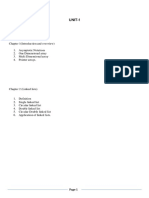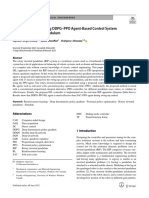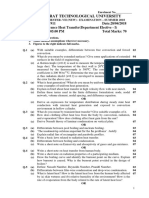DSML Practical
DSML Practical
Uploaded by
focusedbanda117Copyright:
Available Formats
DSML Practical
DSML Practical
Uploaded by
focusedbanda117Copyright
Available Formats
Share this document
Did you find this document useful?
Is this content inappropriate?
Copyright:
Available Formats
DSML Practical
DSML Practical
Uploaded by
focusedbanda117Copyright:
Available Formats
Name: Shreyas Satish Jagadale
Roll No. 322030
Batch B2
PRN:22110649
Assignment 1
AIM: Perform the following operations using R/Python on suitable data sets, read data from
different formats (like csv, xls), indexing and selecting data, sort data, describe attributes of data,
checking data types of each column, counting unique values of data, format of each column,
converting variable data type (e.g. from long to short, vice versa), identifying missing values and
fill in the missing values
OBJECTIVE: Describe the Data Science Process and explore components interaction.
Apply statistical methods for pre-processing and extracting meaning from data to the
application dataset.
ALGORITHM:
An algorithm is a step-by-step procedure or a set of rules for solving a specific problem or
completing a specific task. It serves as a blueprint for performing computations, data processing,
and automated reasoning. Algorithms can be found in various fields such as mathematics, computer
science, and engineering. Here are the key components and characteristics of an algorithm:
Components of an Algorithm:
1. Input: Algorithms take some input as parameters. This input can be zero or more in quantity.
2. Output: Algorithms produce output based on the given input.
3. Definiteness: Each step of the algorithm must be precisely defined and clear.
4. Finiteness: The algorithm must terminate after a finite number of steps.
5. Effectiveness: Every step of the algorithm should be feasible and practical to perform.
6. Correctness: The algorithm should solve the problem it is designed to solve accurately.
Characteristics of Algorithms:
1. Sequential: Algorithms consist of a sequence of steps, each performing a specific operation.
2. Repetitive: Algorithms often contain loops or recursive structures to repeat certain steps until a
specific condition is met.
3. Conditional: Algorithms include decision-making processes where the flow of steps can be altered
based on specific conditions.
4. Deterministic: Given the same input, an algorithm will always produce the same output.
5. Optimality: Algorithms can be optimized for factors such as speed, memory usage, or other
resources.
6. Scalability: Good algorithms can handle larger inputs efficiently without a significant increase in
resources.
Types of Algorithms:
1. Searching Algorithms: These algorithms are used to find a specific item in a collection of
items. - Examples: Linear Search, Binary Search.
2. Sorting Algorithms: Sorting algorithms arrange items in a specific order, such as numerical
or lexicographical. - Examples: Bubble Sort, Quick Sort, Merge Sort.
3. Graph Algorithms: Graph algorithms operate on graphs or networks and are used to solve
problems related to connections and relationships. - Examples: Depth-First Search (DFS), Breadth-
First Search (BFS).
4. Divide and Conquer Algorithms: These algorithms break a problem into smaller
subproblems, solve them, and then combine their solutions to solve the original problem. -
Examples: Merge Sort, Quick Sort.
5. Dynamic Programming Algorithms: Dynamic programming algorithms solve problems by
breaking them down into overlapping subproblems. - Examples: Fibonacci Series using Dynamic
Programming.
6. Greedy Algorithms: Greedy algorithms make locally optimal choices at each step with the
hope of finding a global optimum. - Examples: Dijkstra's Algorithm for finding the shortest path.
7. Recursive Algorithms: Recursive algorithms solve problems by solving smaller instances of
the same problem.
- Example: Factorial Calculation using Recursion.
Code:
You might also like
- Aashto MP1 - 98 PDFDocument4 pagesAashto MP1 - 98 PDFJesús Luis Arce GuillermoNo ratings yet
- LOG-001-T-01 WORKSHOP 2021-04-14 MANUAL REQUISITION HYD21WR 0232 - 0234Document381 pagesLOG-001-T-01 WORKSHOP 2021-04-14 MANUAL REQUISITION HYD21WR 0232 - 0234Ernest Ngosa SawasawaNo ratings yet
- Introduction To AlgorithmDocument27 pagesIntroduction To Algorithmtripathikhushi025No ratings yet
- Algorithm Design and Analyisis NotesDocument37 pagesAlgorithm Design and Analyisis Notesnazamsingla5No ratings yet
- Introduction To Algorithm & Data StructureDocument55 pagesIntroduction To Algorithm & Data StructureAnil Tukaram LoharNo ratings yet
- Data Structure & AlgorithmDocument46 pagesData Structure & Algorithmteddy haileNo ratings yet
- DSA Basic ConceptsDocument6 pagesDSA Basic ConceptsZara NoorNo ratings yet
- Assignment # 1Document4 pagesAssignment # 1muhammaddhananbalochNo ratings yet
- Computer Science1aDocument2 pagesComputer Science1aspacemoon04No ratings yet
- Module 1 DAADocument46 pagesModule 1 DAATUSHAR GUPTANo ratings yet
- DSA Chapter 1Document19 pagesDSA Chapter 1kasutaye192No ratings yet
- DSA Unit - I NotesDocument18 pagesDSA Unit - I Notesneha yarrapothu100% (1)
- BSIT F21 DS & Algo Lecture 1Document21 pagesBSIT F21 DS & Algo Lecture 1aine hNo ratings yet
- DSUnit 1ADocument4 pagesDSUnit 1ApettuganisivaNo ratings yet
- Unit 1.1Document10 pagesUnit 1.1Fardeen KhanNo ratings yet
- Algorithm Chapter 1 (Algorithm Analysis)Document14 pagesAlgorithm Chapter 1 (Algorithm Analysis)Leta TsegayeNo ratings yet
- Unit 1 DsaDocument55 pagesUnit 1 DsaRavishankar BhaganagareNo ratings yet
- What Is Data Structure Exactly 999Document28 pagesWhat Is Data Structure Exactly 999Zarak KhattakNo ratings yet
- What Is An AlgorithmDocument8 pagesWhat Is An AlgorithmjattakcentNo ratings yet
- Algorithm Design Unit 4Document7 pagesAlgorithm Design Unit 4komalkhati457No ratings yet
- CH #2 Solved ExerciseDocument3 pagesCH #2 Solved ExerciseSam HaiderNo ratings yet
- Rational and Factors: For AlgorithmDocument20 pagesRational and Factors: For AlgorithmJobert SarongNo ratings yet
- DS Unit1-1Document17 pagesDS Unit1-1harishekhar3659No ratings yet
- DS Unit IDocument19 pagesDS Unit Ikolavennela90No ratings yet
- Topic 5 AlgorithmsDocument7 pagesTopic 5 AlgorithmssudaisomutoNo ratings yet
- DataDocument28 pagesDatanirjargoswami2626No ratings yet
- Introduction To Data Structure & AlgorithmDocument11 pagesIntroduction To Data Structure & AlgorithmBENJIE ZARATE100% (1)
- AlgorithmsDocument7 pagesAlgorithmssohan soharabNo ratings yet
- Introduction To AlgorithmDocument37 pagesIntroduction To AlgorithmHayat HytNo ratings yet
- DAA Module1Document9 pagesDAA Module1santhoshsubramaniyaNo ratings yet
- Design & Analysis of AlgorithmDocument23 pagesDesign & Analysis of AlgorithmGeorge AdjeiNo ratings yet
- All Document Reader 1708448999806Document31 pagesAll Document Reader 1708448999806AxmedcarbNo ratings yet
- Dsa NotesDocument98 pagesDsa NotesVarsha yadavNo ratings yet
- Introduction To Algorithms-Update2Document12 pagesIntroduction To Algorithms-Update2jonathanmaithya9No ratings yet
- Algorithms and Data StructuresDocument11 pagesAlgorithms and Data StructuresMark Devlin DungoNo ratings yet
- Introduction To AlgorithmsDocument14 pagesIntroduction To Algorithmssedrick tchatchouangNo ratings yet
- Basic Programming ModelDocument4 pagesBasic Programming Modelbrave2112loveNo ratings yet
- DS Unit 1 PDFDocument19 pagesDS Unit 1 PDFNikhil NikkiNo ratings yet
- Algo Analysis Q&A InfoDocument24 pagesAlgo Analysis Q&A Infoanjaneesh airenNo ratings yet
- Data Structures-UNIT IDocument35 pagesData Structures-UNIT Iswarna LathaNo ratings yet
- Characteristics of An Algorithm: Chapter 1 - Algorithm Data Structures and AlgorithmDocument16 pagesCharacteristics of An Algorithm: Chapter 1 - Algorithm Data Structures and AlgorithmLeary John TambagahanNo ratings yet
- Data Structures and Algorithms IIDocument103 pagesData Structures and Algorithms IInkuohthelmathielaNo ratings yet
- CA Assignment Pal 215Document5 pagesCA Assignment Pal 215princessglandy8No ratings yet
- CC204Document8 pagesCC204Shen VillNo ratings yet
- DS Unit IvDocument42 pagesDS Unit IvaaNo ratings yet
- ALGORITHMDocument6 pagesALGORITHMjecielcabrera.fhNo ratings yet
- Data Structures and AlgorithmsDocument3 pagesData Structures and AlgorithmsShawn RelosaNo ratings yet
- Chapter One:data Structures and Algorithm AnalysisDocument209 pagesChapter One:data Structures and Algorithm AnalysisAbey MgNo ratings yet
- Algorithm AllDocument112 pagesAlgorithm AllHabtieNo ratings yet
- Fundamentals of Data Structure Notes (Sppu Sem-1 Unit 1)Document62 pagesFundamentals of Data Structure Notes (Sppu Sem-1 Unit 1)Yash Shinde100% (1)
- Data Structure NotesDocument6 pagesData Structure NotesExclusive MundaNo ratings yet
- DS HandoutDocument110 pagesDS HandoutRewina zerouNo ratings yet
- Shared, Algorithms and Data Structures.Document4 pagesShared, Algorithms and Data Structures.ichaewon557No ratings yet
- UNIT I Data Structures OU CSE First YearDocument19 pagesUNIT I Data Structures OU CSE First Yearjason.orchard.5341No ratings yet
- Data StructuresDocument2 pagesData StructuresDanita Ureta BalastaNo ratings yet
- Algorithm QuestionsDocument3 pagesAlgorithm QuestionsboyzzpinNo ratings yet
- 1-Introduction To Data Stage and Algorithm-22!05!2024Document24 pages1-Introduction To Data Stage and Algorithm-22!05!2024Gaming worldNo ratings yet
- What Is An AlgorithmDocument4 pagesWhat Is An AlgorithmAa ANo ratings yet
- Algorithms and Data Structures: An Easy Guide to Programming SkillsFrom EverandAlgorithms and Data Structures: An Easy Guide to Programming SkillsNo ratings yet
- Engineered Packaging Center A Global ProviderDocument6 pagesEngineered Packaging Center A Global ProviderLTE002No ratings yet
- BeitmanCoincidenceStudies PDFDocument7 pagesBeitmanCoincidenceStudies PDFNaseem M. Al-HumoodNo ratings yet
- Earth DrainDocument5 pagesEarth DrainnurNo ratings yet
- Chapter 6 - Allocating ResourcesDocument60 pagesChapter 6 - Allocating ResourcesAbdur RashidNo ratings yet
- Struts Survival GuideDocument227 pagesStruts Survival GuideUdayan GhoshNo ratings yet
- 3.reinforcement Learning DDPG-PPO Agent-Based Control S YstemDocument14 pages3.reinforcement Learning DDPG-PPO Agent-Based Control S Ystemrajmeet singhNo ratings yet
- Unit 1Document86 pagesUnit 1abhishekNo ratings yet
- Chapter 22 (1) .ElectDocument28 pagesChapter 22 (1) .ElectOsama HassanNo ratings yet
- Trumpet PedagogyDocument9 pagesTrumpet PedagogyRichy SegarraNo ratings yet
- Gujarat Technological UniversityDocument2 pagesGujarat Technological UniversityJag Parvesh DahiyaNo ratings yet
- Magnetism PDFDocument2 pagesMagnetism PDFavinash960No ratings yet
- Sensitivity Analysis NotesDocument23 pagesSensitivity Analysis NotesTheaNo ratings yet
- Vymanika ShastraDocument31 pagesVymanika ShastraPavan Kumar Kallakuri0% (1)
- Interface ShearDocument6 pagesInterface ShearthusiyanthanpNo ratings yet
- Lecture Notes For DSP Control For BLDC Motor DriveDocument34 pagesLecture Notes For DSP Control For BLDC Motor DriveRavi ArunNo ratings yet
- Jeannette Dress Pattern - Sewing and Drafting TutorialDocument24 pagesJeannette Dress Pattern - Sewing and Drafting Tutorialpepeman1100% (3)
- Can Xu 2022Document14 pagesCan Xu 2022Fábio A. BodnarNo ratings yet
- Scale SampleDocument563 pagesScale SampledarebertNo ratings yet
- Impeller ManufacturingDocument21 pagesImpeller ManufacturingmzeshankhadimNo ratings yet
- SDN PCo 03Document23 pagesSDN PCo 03UwedaNo ratings yet
- Calculation of Flexural Crack Width - IS 456: 2000 TB-1: Axial ForceDocument66 pagesCalculation of Flexural Crack Width - IS 456: 2000 TB-1: Axial ForceSrishti Project ConsultantsNo ratings yet
- How To Fix A Corrupted Pen Drive or SD Card Using Command Prompt?Document3 pagesHow To Fix A Corrupted Pen Drive or SD Card Using Command Prompt?Jimboy GwapoNo ratings yet
- Low NoiseamplifierDocument115 pagesLow NoiseamplifierVedran IbrahimovicNo ratings yet
- Unit 1 UpdatedDocument29 pagesUnit 1 UpdatedAmit TripathiNo ratings yet
- Lesson 5 and 6 - Elasticity of Supply and DemandDocument18 pagesLesson 5 and 6 - Elasticity of Supply and DemandCharles Corporal ReyesNo ratings yet
- B O T M B P I: Uild Perate Ransfer Unicipal Ridge Rojects in NdiaDocument8 pagesB O T M B P I: Uild Perate Ransfer Unicipal Ridge Rojects in NdiawinandyaniNo ratings yet
- Links and NavigationDocument16 pagesLinks and NavigationJbr RaheemNo ratings yet
- Conditional Statements in CDocument4 pagesConditional Statements in Cgacc4sitesNo ratings yet

























































































